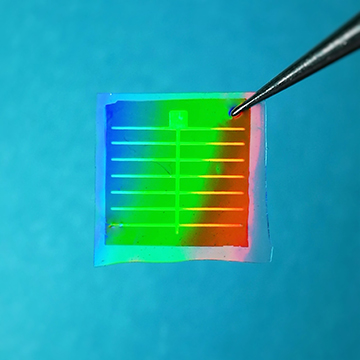
Photograph of a fabricated integrated power system including a TENG and silicon solar cell. [Image: Liu et al. / ACS Nano]
During periods of rain, solar cells fall flat in energy generation. But now, a group of researchers from Soochow University, China, has demonstrated a new integrated power-system design that they say can generate energy from both the sun and from the percussion of raindrops better than previous designs (ACS Nano, doi: 10.1021/acsnano.8b00416). The new iteration’s main improvement is a lightweight, ridged and transparent polymer layer that has a dual purpose: It improves solar-cell efficiency and acts as a shared electrode for solar and raindrop energy conversion.
The design needs further development before it’s ready for real-world use. But the researchers say their demonstrations show a new concept in the harvesting of energy during various weather conditions.
Reducing bulk, increasing performance
Pairing a raindrop triboelectric nanogenerator (TENG) with a solar cell is a way to collect energy from the environment when the sun isn’t shining: The solar cell generates electricity when the sky is clear, and the TENG converts energy from water hitting its surface into electricity when it rains. However, past designs have simply stacked the TENG on top of the solar cell. In these designs, the two energy-harvesting layers each have their own electrodes and are separated by an insulating layer with a conducting wire that connects them. The resulting devices work, but they are bulky and energy inefficient.
The new design proposed by the Soochow researchers reduces the heft of previous integrated TENG/solar-cell designs by incorporating a lightweight polymer electrode made of poly(3,4-ethylenedioxythiophene):poly(styrenesulfonate) (PEDOT:PSS) that is shared by a heterojunction silicon solar cell and a lightweight TENG made out of the polymer polydimethylsiloxane (PDMS).
The team also improved the efficiency of both halves of the integrated power system by imprinting the PEDOT:PSS electrode and the PDMS TENG with ridges, using a commercial DVD as a template. The ridges on the PEDOT:PSS layer improve the solar cell’s function by reducing light reflection, which increases short-circuit current density and improves power conversion efficiency (PCE). The ridges on the PDMS layer increase the surface contact area for raindrops, which increases TENG output.
Demonstrating the integrated power system
The researchers tested the performance of the power system’s solar and TENG components separately before demonstrating a model of the entire integrated power system. They began by establishing that the ridged pattern of the PEDOT:PSS layer is the key to improving the solar cell’s efficiency. To do so, they exposed three different solar-cell wafer and PEDOT:PSS electrode combinations to a simulated solar spectrum. The combination of a smooth solar cell and a ridged PEDOT:PSS electrode achieved a PCE of 13.6 percent, the combination of a textured solar cell and a smooth PEDOT:PSS electrode achieved a PCE of 12.6 percent and the combination of both a smooth solar cell and PEDOT:PSS electrode only achieved a PCE of 12.0 percent.
The team also confirmed that a ridged TENG performs better than a smooth TENG by recording electrical output characteristics from both. The tests revealed that the ridged TENG had a voltage output four times higher than that of the smooth TENG. Specifically, they observed a peak short-circuit current of about 33.0 nA and a peak open-circuit voltage of about 2.14 V.
Finally, when the researchers combined the silicon solar cell and TENG into a model integrated system, they found that it was capable of simultaneously converting solar energy and raindrop energy into electrical power.
